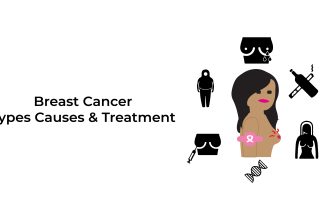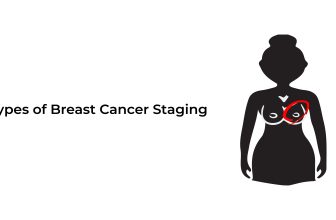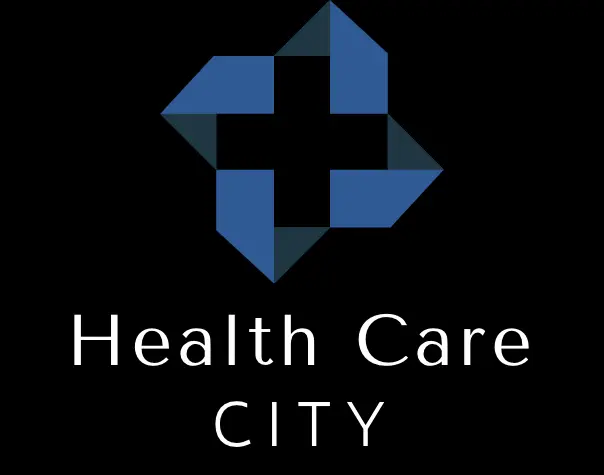Breast Cancer Lump
A breast cancer lump is painless, stiff, uneven, or irregular shaped; different from the surrounding breast tissue. The skin covering of the lump looks like an orange peel dimpled or pitted. The size and shape of the breast may change, and one may notice a discharge from the nipple.
Types of breast cancer lumps
Breast cancer types include;
Ductal carcinoma in situ (DCIS):
Ductal carcinoma in situ is chronic cancer where abnormal cells have been formed in the breast milk duct lining. The abnormal cells do not proliferate outside of the ducts into surrounding breast tissues. Ductal carcinoma in situ is advanced cancer that is treatable, but if left untreated, then it grows in the surrounding areas of breast tissues. Early-stage cancer is known as carcinoma in situ.
Invasive ductal carcinoma (IDC):
Invasive ductal carcinoma is progressive cancer where abnormal cancer cells start forming in the milk ducts and start spreading into the other parts of the breast tissues. It can also extend into the different parts of the body. It is also called infiltrative ductal carcinoma.
Invasive ductal carcinoma is a most common and ordinary type of breast cancer, making up 70-80% of all kinds of breast cancer diagnoses. IDC mainly affects men.
Lobular carcinoma in situ (LCIS):
In lobular carcinoma in situ, abnormal cancerous cells are present in the breast’s lobules. Abnormal or cancerous cells do not spread outside the lobules into the surrounding breast tissues. Lobular carcinoma in situ is treatable and rarely becomes invasive cancer; if the LCIS is present in one breast, the risk of its development increases in the other breast.
Invasive lobular cancer (ILC):
Invasive lobular cancer starts in the breast’s lobules and spreads to the nearest normal tissues. It can also spread by the blood and lymph system to the other parts of the body. Invasive lobular breast cancer is the next or second most usual or standard type of breast cancer. Mammograms are essential and helpful, but they are less likely to discover invasive lobular breast cancer than other breast cancers. Invasive lobular breast cancer doesn’t occur clearly in mammograms; alternatively, MRI might be required.
Triple-negative breast cancer:
Within triple-negative breast cancer, the three most common receptors (estrogen, progesterone, and the HER- 2/neu gene) are known to fuel most breast cancer growth, and they are not present in cancer cells. It means that the breast cancer cells have been evaluated negatively for hormone epidermal growth factor receptor 2, progesterone receptor, and estrogen receptor.
So, the tumor cells are deficient in necessary receptors; standard treatment is hormone therapy and drugs that target HER- 2, progesterone, and estrogen, which are ineffective. Chemotherapy used for the treatment of triple-negative breast cancer is still effective. Chemotherapy responds better in an earlier stage than other stages of breast cancers. Breast cancer mainly affects Africans, Americans, and those with gene mutation, and at least 10-20% of people diagnosed with it.
Triple-negative breast cancer can be violent and challenging to treat. It is more likely to recur and spread.
Inflammatory breast cancer (IBC):
Inflammatory breast cancer is a fast-growing and violent cancer in which cancer cells infiltrate the lymph vessels of the breast and the skin. It doesn’t form a distinct tumor that can be isolated from the breast. Symptoms start to appear when the breast cancer cells block the lymph vessels. Symptoms include;
- Appearance of rash
- Persistent itching
- Small irritation
- Breast become swollen, red, warm
- Skin looks like an orange peel (pitted)
- Changes occur in the nipple (inversion, flattening, dimpling appear in the nipple)
Doctors do biopsies to diagnose the cancer stage.
IBC grows swiftly and needs aggressive treatment. Treatment includes;
- Surgery
- Chemotherapy
- Radiation therapy
- Hormone treatment
Metastatic breast cancer (MBC):
Metastatic breast cancer is stage 4 breast cancer. Cancer expands to the other parts of the body. It usually spreads in the lungs, liver, bones, or brain. Metastatic breast cancer spreads by following steps;
- Cancer cells take over nearby healthy cells
- Cancer cells invade or penetrate the circulatory system
- Migration by circulation
- Cancer cells enter into capillaries
- New tumors grow
Symptoms of metastatic breast cancer may vary from person to person. Symptoms of metastatic cancer in bones include;
- Severe pain
- Swelling
- Fractured bones
Metastatic cancer in the brain cause;
- Frequently worsening headache
- Vision disturbance
- Seizures
- Nausea
- Vomiting
- Personality changes
- Behavior changes
Metastatic cancer in liver causes;
- Skin rashes
- Jaundice
- Enzymes work abnormally
- Loss of appetite
- Nausea
- Vomiting
- Abdominal pain
Metastatic cancer in the lungs cause;
- Chronic cough
- Abnormal X-ray of the chest
- Chest pain
- Difficulty in breathing
- Fatigue
- Weight loss
Breast cancer during pregnancy:
Breast cancer during pregnancy is not caused by pregnancy. Women driven by breast cancer during pregnancy are under additional stress due to the worry about the unborn child’s safety. It is challenging, but many treatment options are available for both mother and child. Extra medical care for pregnant women with breast cancer can treat cancer and prevent the baby. Breast cancer treatment during pregnancy depends on the cancer cells, location, and size. Treatment includes;
- Surgery
- Lumpectomy
- Mastectomy
- Chemotherapy
- Hormone therapy
Other types:
Other types of breast cancer are less commonly seen;
- Medullary carcinoma
- Tubular carcinoma
- Mucinous carcinoma
- Paget disease of the breast or nipple
Painful lump in the breast:
The causes of a painful lump in the breast are the following;
- Infection
- Fibroadenoma
- Cyst
- Fat necrosis
- Lipoma
- Breast cancer
Hard lump in the breast:
Breast cancer feels like a complex and firm nodule or lump. It is commonly irregular and may feel fixed with skin or tissues deep inside the breast. And hard to extract out.
Dimpling of the breast skin:
Dimpling in the breast can be a sign of severe or notable breast cancer known as inflammatory breast cancer. Dimpling in the breast makes skin like an orange, uneven, and pitted. Sometimes, the skin seems red and inflamed. The following changes may appear;
- Changes in skin
- Thickening of tissues
Dimpling of the breast skin is caused by;
- Inflammatory breast skin
- Fat necrosis
- Breast injury or surgery
- Breast cancer
Moveable lump in the breast:
A moveable lump in the breast can make you frightening and upset. A node that moves quickly with the fingers cannot usually be cancerous. A few things that cause moveable lump include;
- Fibrocystic changes.
Symptoms include;
- Swelling
- Tenderness
- Nipple discharge
- Pain
- Tenderness
- Lumpiness
- Breast abscess.
- Soreness
- Redness
- Warm skin
- Swelling
- Fever
- Fatigue
- Sclerosing adenosis.
Breast cyst treatment:
No treatment is needed or required if the cyst is small, painless, and uncomfortable. Many cysts go away without treatment. If the cyst appears frequently, it feels more complex, or skin changes, follow the doctor. Treatment includes;
Fine needle aspiration:
Doctors do fine needle aspiration by doing an ultrasound and using a needle. The needle injected the fluid from the breast lump. If the fluid disappeared from the breast, then symptoms resolved.
If the breast cyst is recurrent, then drained with other procedures.
Hormone use:
Using oral contraceptives to regulate the menstrual cycle reduces the chances of recurrent breast cysts. But oral contraceptives have significant side effects. Another hormone therapy like tamoxifen is recommended for women with severe symptoms.
Surgery:
In very severe cases, doctors do surgery to drain the breast cyst.
Lifestyle changes and home remedies:
There are some lifestyle modifications and home remedies to minimize the discomfort, including;
- Wear a supportive bra
- Try compress
- Avoid caffeine
- Try painkillers that prescribed by your doctor
Pain in breast, no lump:
Sometimes pain occurs in the breast due to some hormonal changes, maybe due to an unfitted bra; changes in breast size also cause pain in the breast.
Breast tumor symptoms:
Breast cancer or tumor signs and symptoms can vary from person to person. Most people don’t feel any symptoms. Early warning signs and symptoms include;
- Lump under the arm or breast
- Swelling in the armpit
- Pain
- Tenderness
- A flat area on the breast
- Changes in the breast
- Changes in the nipple;
- Dimpled
- Burn
- Pulled outward
- Itches
- Sores developed
- Unusual nipple discharge
- A marked area of skin
References:
- https://www.nationalbreastcancer.org/types-of-breast-cancer/
- https://www.healthline.com/health/breast-cancer/movable-lump-in-breast
- https://www.mayoclinic.org/diseases-conditions/breast-cysts/diagnosis-treatment/drc-20370290
- https://www.webmd.com/breast-cancer/understanding-breast-cancer-symptoms






